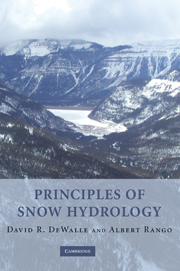Book contents
- Frontmatter
- Contents
- Preface
- 1 Introduction
- 2 Snow climatology and snow distribution
- 3 Snowpack condition
- 4 Ground-based snowfall and snowpack measurements
- 5 Remote sensing of the snowpack
- 6 Snowpack energy exchange: basic theory
- 7 Snowpack energy exchange: topographic and forest effects
- 8 Snowfall, snowpack, and meltwater chemistry
- 9 Snowmelt-runoff processes
- 10 Modelling snowmelt runoff
- 11 Snowmelt-Runoff Model (SRM)
- 12 Snowpack management and modifications
- Appendix A Physical constants
- Appendix B Potential solar irradiation theory
- Index
- Plate Section
- References
10 - Modelling snowmelt runoff
Published online by Cambridge University Press: 18 August 2009
- Frontmatter
- Contents
- Preface
- 1 Introduction
- 2 Snow climatology and snow distribution
- 3 Snowpack condition
- 4 Ground-based snowfall and snowpack measurements
- 5 Remote sensing of the snowpack
- 6 Snowpack energy exchange: basic theory
- 7 Snowpack energy exchange: topographic and forest effects
- 8 Snowfall, snowpack, and meltwater chemistry
- 9 Snowmelt-runoff processes
- 10 Modelling snowmelt runoff
- 11 Snowmelt-Runoff Model (SRM)
- 12 Snowpack management and modifications
- Appendix A Physical constants
- Appendix B Potential solar irradiation theory
- Index
- Plate Section
- References
Summary
Introduction
Hydrologic models used to predict streamflow can be generally classified as either deterministic or stochastic and as either lumped-parameter or distributed (Beven, 2000). Deterministic models predict a single value of streamflow from a given set of input variables, while stochastic models predict a range of possible outcomes based upon the statistical distributions of input variables. Nearly all of the snowmelt models used to continuously predict streamflow from snowmelt are deterministic, but a type of statistical model has been historically used to great advantage to predict seasonal totals of streamflow using measured snowpack and precipitation data each spring. These models are in widespread use in the western United States to forecast spring runoff.
Deterministic models can be further categorized as either lumped-parameter or distributed. Lumped-parameter models consider the entire watershed as a homogeneous unit, while distributed models break the watershed into subunits or grid points based upon a variety of criteria. Early snowmelt models were of the lumped-parameter type, but many distributed-snowmelt modelling studies have been conducted in the past decade. In terms of snowmelt prediction, the lumped-parameter type of model assumes that the snow cover and melt rates are uniform across the entire basin. These so called point-snowmelt models are still in use today and are generally found imbedded in most deterministic, distributed models. Distributed-snowmelt models generally adapt simple point-snowmelt models for conditions that vary from point to point across basins.
- Type
- Chapter
- Information
- Principles of Snow Hydrology , pp. 266 - 305Publisher: Cambridge University PressPrint publication year: 2008
References
- 4
- Cited by



